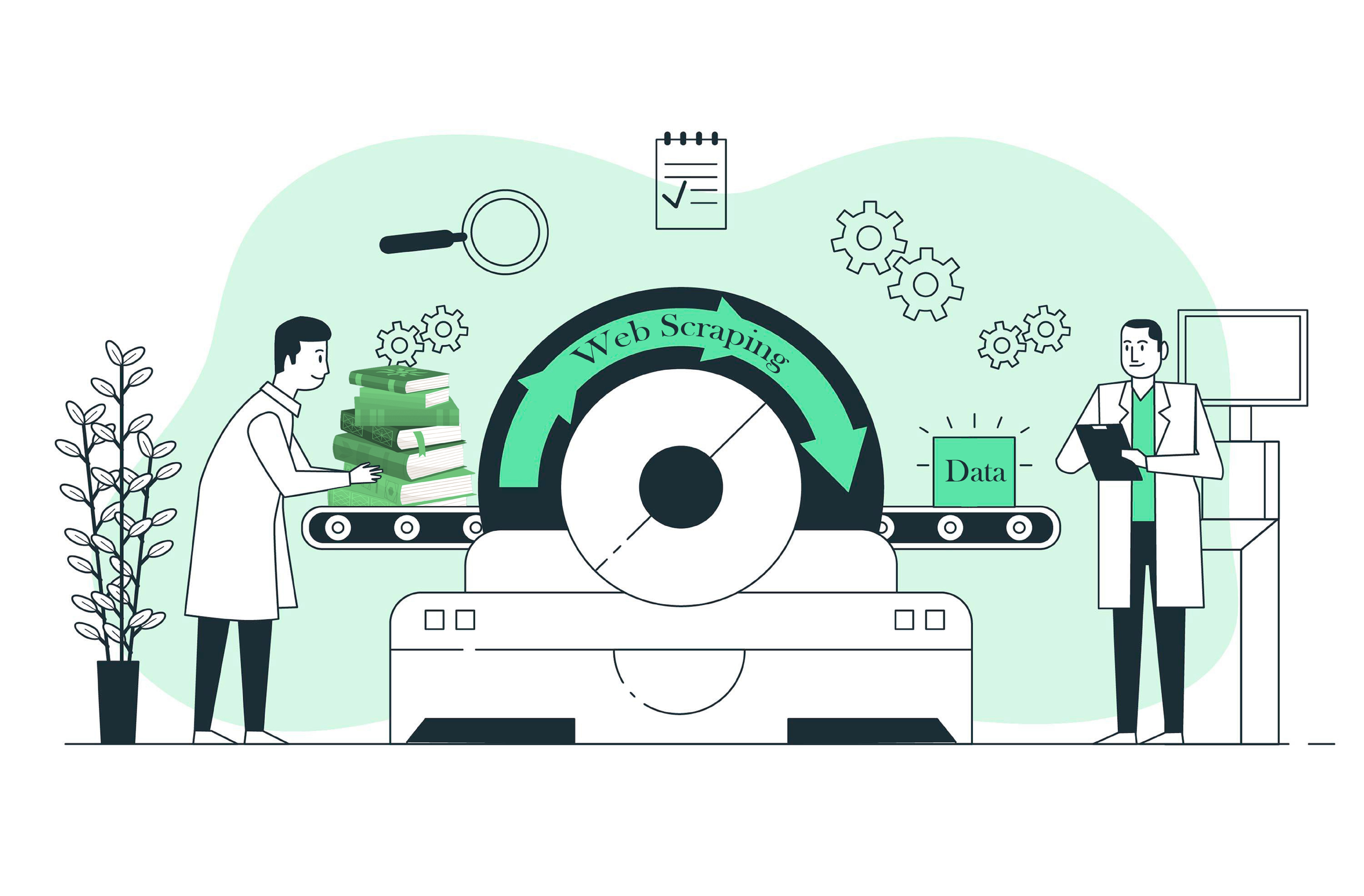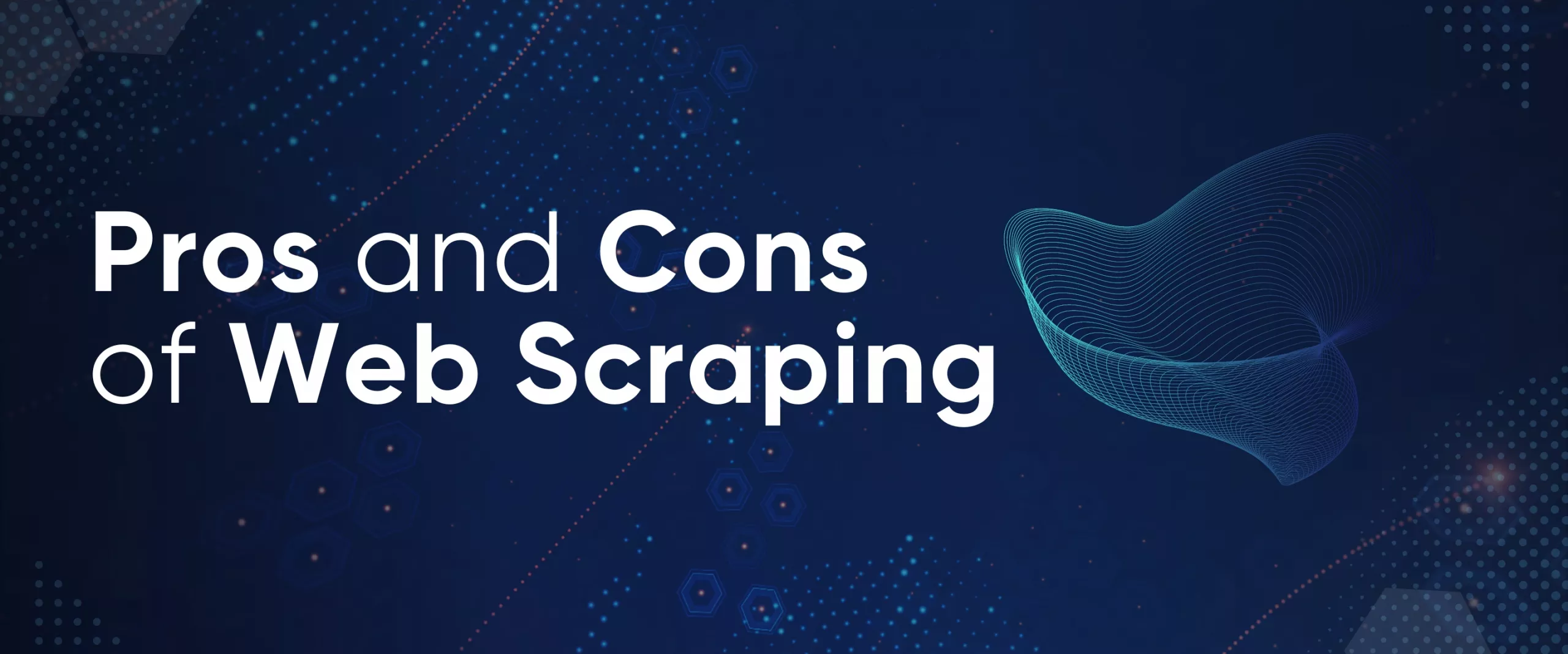We've discussed web scraping a lot – what it is, how and why to use it. We even discussed different data extraction methods from Amazon, Yelp, Walmart or Zillow.
Today we will be looking at both advantages and disadvantages of web scraping. Plus, we'll give you some useful tips on rules to follow when carrying out your scrape operations.
Benefits of Web Scraping
There are many reasons to use web scraping and web crawling. First, it allows you to collect web data quickly and efficiently, whereas manually collecting such data would take many hours and require long, monotonous work from humans.
All data is collected and stored in a convenient and structured way. Therefore, they are immediately suitable for further work with them, for example, for data analysis.
Before we look at the pros and cons of web scraping in detail, let's look briefly at the table:
|
Pros of Web Scraping |
Cons of Web Scraping |
|---|---|
|
Cost-effective: Saves money compared to manual collection |
Time-consuming to set up and requires technical expertise |
|
Time-saving: Automates data collection process |
Anti-scraping measures and IP blocking can be challenging |
|
Provides accurate and up-to-date data |
Legal and ethical implications must be considered |
|
Supports improved decision making |
Data quality and reliability issues |
|
Offers customization and flexibility |
Requires maintenance and monitoring |
|
Enables scalability for projects of any size |
Privacy and security risks |
|
Provides a competitive advantage over competitors |
Resource-intensive and scalability challenges |
|
Supports research and analysis |
- |
|
Automates repetitive tasks |
- |
|
Facilitates integration with other systems |
- |
Now let's inspect the pros and cons of web scraping.
Cost-effective
Using web scraping is more economical than paying for manual data collection by humans. Plus, data is only worthwhile if it is current and meaningful. Scraping makes this possible, while manual collection does not. This helps you get only an up-to-date and useful dataset for your project.
Time-saving
Scraping technology allows you to automate the process of collecting data, saving you from having to hunt through web pages manually. Instead of wasting countless hours trawling through large amounts of data, scraping can help you save both time and effort. With those extra hours, you can focus on something else.
Accurate and Up-to-date Data
Web scraping is an effective way to ensure you always have access to data accuracy. With web scraping, you can always be sure you're looking at the most recently-available information, such as the changes in your competitor's prices or lead generation in your industry. Plus, web scraping helps you identify trends and predict future innovations. These features make web scraping a great tool, especially when your data has to keep up with a rapidly changing market.
Effortlessly extract Google Maps data – business types, phone numbers, addresses, websites, emails, ratings, review counts, and more. No coding needed! Download…
Google SERP Scraper is the perfect tool for any digital marketer looking to quickly and accurately collect data from Google search engine results. With no coding…
Improved Decision Making
Making decisions can be challenging, but having up-to-date data and the ability to track changes over time makes it much simpler. Scraping is a great way to collect important information while organizing it for easier decision-making – ultimately leading to better outcomes.
Customization and Flexibility
Web scraping tools are incredibly useful and versatile. They can be easily tailored to your requirements so that you can get the most out of them. With this flexibility, you can customize data scraping tools according to what works best for your project or task at hand. This ensures that whatever data needs extracting from a website is collected quickly and efficiently without wasting time.
Scalability
One of the great advantages of web scraping is its scalability. Whether you're working on a small project or something much bigger, web scraping software is flexible enough to accommodate any size and scope. That means they can easily grow with your projects as needed, no matter how big they get.
Competitive Advantage
Web scraping provides a quick and efficient way to get up-to-date information. This can be a huge advantage for you over your competitors, who may not have access to the same data scraping tools as you do. By taking advantage of this data, you can gain insights into market trends, customer preferences, and potential opportunities emerging in your industry.
Research and Analysis
Web scraping is a great way to quickly and easily collect the needed data. Not only does it provide the information in an organized format, but some scrapers also let you pre-process it while collecting.

This makes web scraping invaluable for researchers performing academic studies, market research or scientific analysis. With web scraping, they can access huge amounts of data to help them draw meaningful conclusions from their findings and support their research results.
Automating Repetitive Tasks
To stay ahead, it's essential always to have up-to-date information. To ensure you never miss a beat, web scraping is a great way to automate data collection and extraction for those frequently recurring tasks. Automating these processes frees up your time so that you can focus on more complex and valuable tasks.
Integration with Other Systems
The use of web scraping tools like the web scraping API can be extremely beneficial for any project or program. Through integration, it's easy to take the data collected from web scraping and seamlessly incorporate it into existing databases, business intelligence systems, or analytical platforms — allowing you to take full advantage of its potential. This simplifies further analysis and visualization, giving you access to a wealth of previously inaccessible information.
Disadvantages of Web Scraping
Despite all the benefits of web scraping, it has some drawbacks and difficulties. Setting up a web scraper properly can be time-consuming and require technical expertise. Additionally, websites often use anti-scraping techniques such as captchas or IP blocking, making it difficult for your scraper to access data from certain sites. Web scrapers are also prone to breaking when website designs change because they rely on specific HTML structures to work correctly.
Technical Challenges and Website Variability
Web scraping can be a powerful tool for data collection, but it also presents some technical challenges. Most notably, websites have their own unique structure and layout, which must be considered when developing scrapers. Each website requires different techniques or custom-built parsers to extract the desired information. Additionally, since web content constantly changes, existing scrapers may need regular updates to remain effective. Creating your own scraper from scratch might make more sense if you regularly collect data from multiple sites with varying formats and layouts.
On the other hand, many pre-made web scraping APIs available online can help simplify extracting data across different sources quickly and efficiently without needing programming skills or having to build custom parsers for every site you visit.
IP Blocking and Anti-scraping Measures
Many websites take steps to prevent bots from accessing their data and interacting with content. This is mainly done to protect against spam bots and DDOS attacks. They may use different measures such as IP blocking, CAPTCHA challenges, or rate limiting to do this. These measures can make it difficult for scrapers by requiring additional resources like proxies, IP rotation or CAPTCHA-solving services, which add complexity and costs to the scraping process.
Legal and Ethical Issues
Web scraping can be a valuable tool, but it's important to understand your activities' legal and ethical implications. While web scraping public data is generally permissible, you must avoid violating website terms of service, copyrights, or privacy policies. You must comply with all applicable laws and guidelines when using web scraping technologies to stay on the right side of the law.
Data Quality and Reliability Issues
Web scraping is a great tool for collecting and organizing data, but ensuring you get the right data from the right source is important. To ensure your web scraper works correctly, you must configure it properly.
But even if everything is configured correctly, there can be issues with the quality of your scraped data. This includes missing or inconsistent information, inaccuracies or outliers that could affect your results' reliability and accuracy.
To protect against this kind of problem, consider implementing processes like data validation and cleaning into your workflow so that you can trust in the integrity of what you have collected.
Shopify scraper is the ultimate solution to quickly and easily extract data from any Shopify-powered store without needing any knowledge of coding or markup! All…
Maintenance and Monitoring Requirements
When using and creating scrapers, monitoring for changes on the website is essential. This includes eliminating bugs in its operation as well as developing new functionality. The scraper will soon become outdated and useless if this isn't done regularly. Websites often alter their layouts, structures or content, which can easily break existing scraping scripts. Therefore, regular low maintenance and monitoring are crucial to ensure that your scraping tools stay up-to-date with any website changes so you can guarantee accurate data extraction every time.
Privacy and Security Risks
The purpose of web scraping is to collect data. This information can be incredibly valuable in the digital age and must be handled responsibly. When you scrape data from websites, it's essential to take steps that ensure both privacy and security are maintained. This means respecting applicable personal data protection regulations and implementing measures that safeguard scraped content and systems used for scraping activities.
Resource Intensive and Scalability Challenges
Maintaining a constantly running web scraper that preserves the data it collects can be resource intensive. Additionally, scalability is an issue to consider - if the project isn't designed to scale from the start, it could become a problem.
When scraping large amounts of data or multiple websites simultaneously, significant bandwidth and processing power are required alongside plenty of storage space. Optimizing resource usage while scraping data requires suitable infrastructure and techniques for success.
Best Practices of Web Scraping
When it comes to web scraping, following some best practices is essential. Doing so can help ensure you can collect the data you need without causing any harm or damage to the website in question. These practices are important as they ensure your web scraping activities abide by all applicable laws and regulations.
Identify and Honor Robots.txt Guidelines
Regarding web scraping, respecting a website's Robots.txt file is important. This file is the site owner’s way of communicating which parts of their website are allowed (or disallowed) for web crawlers and scrapers. Taking this into account will ensure that you don't violate any rules or regulations set by the owners, as they reserve the right to block access if these guidelines aren't followed.
Therefore, before you scrape data from a particular site, it is advisable to review its Robots.txt to ensure that your actions comply with the established permissions and restrictions on accessing data on that site.
Implement Proper Rate Limiting and Throttling
When scraping a website, it is important to practice good habits. You should always delay your requests and make sure you are not overloading the site by scraping during peak times. It's best to scrape when the load on the server is minimal - like in the middle of the night or early morning hours.
It's also important to implement rate limiting and throttling measures so you don't overwhelm a target website with too many requests at once, which could cause serious issues for their servers. Rate limiting controls how frequently you send out requests, while throttling helps control how much data can be sent back from each request, ensuring that both sides remain responsible throughout web scraping activity.
Use Proxies and Rotate IP Addresses
Scraping can be tricky, and your IP address may be blocked if you're not careful. To avoid this problem, it's important to use proxies, which will mask your real IP address and make each request seem to be coming from a different user.

By using proxies in combination with rotating IP addresses, you'll be able to distribute web scraping requests across multiple locations while maintaining anonymity at the same time. This ensures that services won't block any of your requests due to too many coming from one place or person.
Handle Dynamic Content and JavaScript Rendering
Scraping dynamic web pages can be more challenging. To capture all the data, you may need a headless browser. This program acts like a user - it runs and interacts with pages as if human-controlled. Many websites are built with JavaScript frameworks that render information dynamically, so special techniques such as using headless browsers or JavaScript execution engines must be used to extract the desired data from these sites correctly.
Validate and Clean Scraped Data
Before using the data for analysis or further processing, it's important to ensure it is complete and in the right form. This means validating and cleaning it to fix incorrect characters, extra spaces, or inconsistencies. Cleaning the data also helps preserve its integrity by removing unwanted elements like typos or incomplete information. Validation helps ensure the accuracy and reliability of your scraped data before you start using it.
Monitor Website Changes and Adapt Scraping Techniques
Scraping data from websites can be a valuable tool but requires regular maintenance. Websites can change their structure to protect themselves and prevent scraping, so your scraper must be updated with the latest changes to remain effective.
Additionally, websites may develop new ways to protect themselves against scrapers, so you must keep track of these developments. Regularly monitoring target sites for any changes and adapting your scraping techniques will ensure you can continue extracting the desired data.
Conclusion
In conclusion, web scraping is a one-time investment with numerous advantages and disadvantages that must be carefully considered. On the positive side, web scraping provides a cost-effective and time-saving method for gathering large amounts of data. It enables businesses to make informed decisions, research, and gain a competitive edge. Additionally, web scraping offers customization, scalability, and automation benefits, streamlining workflows and improving efficiency.
However, there are challenges and drawbacks to be aware of. Technical challenges and website variability require adaptability and expertise in scraping techniques. IP blocking and anti-scraping measures may hinder the scraping process, necessitating proxies and IP rotation.
By understanding and carefully navigating the pros and cons of web scraping, and e-commerce, businesses and researchers can harness its power to gain insights, make informed decisions, and stay competitive in today's data-driven world.


